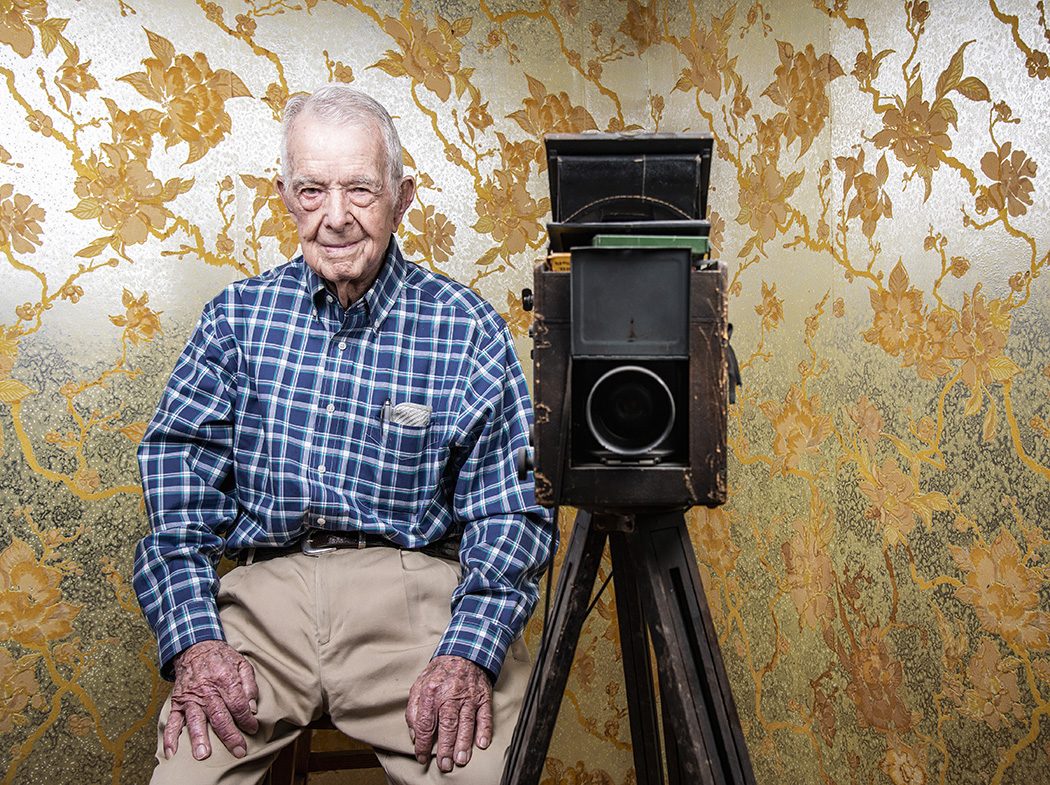
(Photography by Danny Fulgencio.)
Brad Bradley photographed his first Cotton Bowl in 1948 and hasn’t missed a game in the 72 years since.
While snapping pictures of Heisman Trophy winners and future pros at one of college football’s oldest and most iconic games, Bradley became a legend in his own right.
His 72-year streak at the Cotton Bowl is an unprecedented achievement in sports history, and in 2007, it earned him a place in the Cotton Bowl Hall of Fame. He’s the only photographer to ever be inducted.
“So much of my life has been fun,” Bradley says. “I had a family that supported me and made it such a pleasant thing to do.”
Bradley’s career started in late 1946, about a year after serving in Okinawa during World War II. Within months of returning home, he married his wife, Betty, whose parents were renowned Associated Press photographers, Jim and Iris Laughead.
Laughead had just signed a contract to shoot yearbook photos at Southern Methodist University and needed help. He recruited the couple, and together, the family opened Laughead Photography in what is now a Jimmy John’s at 6411 Hillcrest Ave.
During their heyday, Bradley and Laughead took pictures for more than 40 college teams, primarily in the Southwest and Southeastern conferences. They even had a few patrons in the NFL.
A football program from the 1956 matchup between Ole Miss and Alabama described their operation like this:
“They drive up in a station wagon stuffed with equipment. Bradley always drives, with Laughead sitting on the right puffing on an expensive cigar — dressed in his overalls, vest and hat — with a thermos of ice water between his knees.”
The duo pioneered the huck ’n’ buck technique that defined the next three decades of sports photography. In the early days of college football, photographers struggled to capture the action without autofocus and telephoto lenses, which had not yet been invented.
Laughead’s idea was to photograph players in posed positions to make them appear as if they were in action. Think of the leaping stiff-arm or the “Death Dive” in which linemen jump into the air with their arms raised, as if tackling a ball carrier. Another popular shot was of a player holding a ball in the crook of his arm with his opposite leg raised and other arm extended in a block.
Their clientele included Heisman winners Doc Blanchard, Pete Dawkins, Roger Staubach, Tony Dorsett and Earl Campbell. But Bradley’s favorite photo subject was running back Doak Walker, who earned All-America honors in three seasons at SMU and went on to lead the Detroit Lions to two NFL championships.
“I think my favorite thing was to be in the presence of Doak Walker,” Bradley says. “He was such a kind and generous person. He loved everybody and did so many good things for people.”
Walker led SMU to the Cotton Bowl against Penn State in Bradley’s first year working the event. He witnessed one of the most significant games in college football history when Penn State became the first team to compete with African-American players in a high-profile game in racially segregated Texas.
The 1948 game was the first of many memorable Cotton Bowls for Bradley, who also shot the 1979 “Chicken Soup” game between Notre Dame and Houston. Notre Dame quarterback Joe Montana had the flu and was struggling to stay warm during the frigid matchup. After eating chicken soup at halftime, Montana erased a 22-point deficit to win 35-34.
“Dad is a witness to a lot of history,” Bradley’s son, Jimmy, says. “He’s seen a lot of changes that have been made over this period of time. He’s been part of that.”
Bradley and his wife ran Laughead Photography, later renamed Bradley Photography, until 1990. But the 97-year-old wouldn’t say he’s retired. With Jimmy’s help, Bradley still photographs the Doak Walker Award, given to the top running back in college football, and the Tate Lecture Series at SMU.
“He has a truly gifted eye,” Jimmy says. “He’s a natural. I’ve learned a lot from him. I have the privilege of seeing him work and helping him out.”
Bradley is also the oldest member of the Exchange Club of East Dallas, joining in 1956. Although he’s on the retired list, he remains active in the club, attending each Wednesday meeting at the Lakewood Country Club.
“Over the years, it’s been a really inspiring club,” Bradley says. “I believe the purpose of the club is certainly without question. I’ve been there a long time, and it has been nothing but pleasure.”





